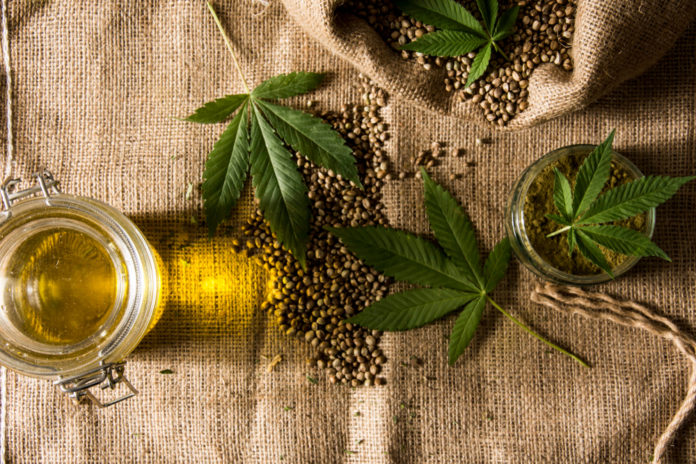Hemp is awesome and one of the world’s earliest cultivated crops. There are as many uses for hemp, as there are celebrities in Lil Dicky’s new NSFW pro-environment viral video, “Earth” (proceeds of sales for the single will benefit Leonardo DiCaprio’s environmental foundation).
Today, on the 49th annual Earth Day, taking care of Planet Earth has taken on new urgency, as the world experiences the global effects of climate change and pollution. Scientist and environmental experts have called for rapid, drastic change in order to start undoing some of the negative effects, as well as aggressive development of renewable resources for energy and raw materials—and hemp can be an important part of that, if we let it.
Even though hemp has been under prohibition in the U.S. since the ‘30s, the U.S. is the largest importer of hemp products from countries where it can be legally grown, including France, the Netherlands, and China. The 2018 Farm Act approved by Congress last year contains provisions for U.S. farmers to legally grow hemp crops, but governmental regulation processes and bringing hemp production to scale for American farms is slow moving.
Here are just a few of the cool things you can do with hemp, to help save the planet:
Rope–Probably one of the most ancient uses for hemp, rope is an important product still made from hemp fibers. The first traces of hemp use date back to 8,000 B.C.E., where hemp fibers have been found in areas of Asia. Renowned for strength and durability, early examples of hemp cord can be traced to China. Hemp made its first appearance in Europe around 1,200 B.C.E., but was used throughout the ancient world.
Textiles–Another early use of hemp that continues today is for textiles; again, due to the strength of its fibers. From canvas to knits to fine linens, hemp has been used to make sails, tarps, carpet, and apparel, among other textile products. Resistant to mold and microbials, hemp has also been used extensively for its antiseptic properties in hospital bedding and uniforms for healthcare workers.
Paper–The first hemp paper produced can be traced back to approximately 2,200 B.C.E., when the hemp paper was used in China, with its use eventually spreading to Korea and Japan. Europe saw the arrival of hemp papers from the Middle East during the thirteenth Century. Hemp, which contains more cellulose and lower levels of lignin, requires less processing than wood, which has traditionally been used in the U.S. to manufacture paper. Hemp paper with high “rag” content can be created from repurposed remnants of discarded hemp fabrics and materials.
Hemp Oil–A significantly important use for hemp is extracting its oil for a variety of industrial purposes, as well as for personal care in soaps, shampoos, detergents, and skincare products. Hemp oil is used industrially as a lubricant, and in paints, inks, and varnishes. While containing varying levels of CBD (aka cannabidiol) depending on source material, hemp oil contains only trace amounts of psychoactive cannabinoid compound THC (found in cannabis), and so hemp oil cannot make you “high” when ingested or applied topically.
Biofuels–For many years, researchers and scientists have known the potential for hemp to be processed into biodiesel and bio-ethanol, and have speculated that fuels derived from plant sources, like hemp, could be used someday to replace fossil-burning fuels with a cleaner burning alternative. Biofuels also can be produced from vegetable oils, animal fats, or recycled restaurant grease. Hemp, which can be grown quickly and materials used for other products after oil has been extracted, could be a significant crop if use of biofuels increases.
Building Materials–Versatile and strong, hemp as a raw material can be turned into almost any building material, including roofing, flooring, wallboard, caulking, cement, paint, particleboard, plaster, plywood, reinforced concrete, insulation, bricks, and biodegradable plastic composites, among others. The first U.S. home to utilize concrete-like product “hempcrete” was built in 2010, in Asheville, North Carolina. At that time, due to U.S. federal cannabis prohibition, hemp used in the construction had to be resourced from the U.K., significantly raising costs for the builder.
Superfood–Natural nutrition experts and practitioners have long considered hemp seeds a “superfood,” rich in essential fatty acids and other nutrients. Hemp seeds are packed with protein, antioxidants, fiber, vitamins, and minerals. Easily available in the U.S. and worldwide, hemp seeds (also known as “hemp hearts”) have been used for decades as an ingredient in cereals, protein bars, and natural foods. Hemp seeds are processed to produce hemp milk (similar to other plant-based, non-dairy milk products). Many commercial bird feed mixes also contain hemp seeds.


